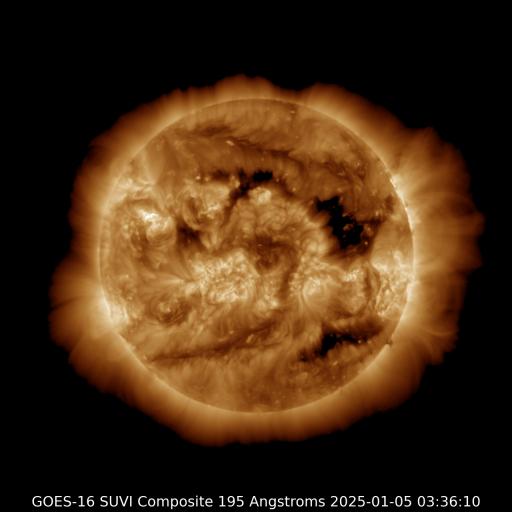Viewing archive of Monday, 20 January 2020
Daily bulletin on solar and geomagnetic activity from the SIDC
Issued: 2020 Jan 20 1231 UTC
SIDC Forecast
Solar flares
Quiet conditions (<50% probability of C-class flares)
Geomagnetism
Quiet (A<20 and K<4)
Solar protons
Quiet
| 10cm flux | Ap | |
|---|---|---|
| 20 Jan 2020 | 072 | 005 |
| 21 Jan 2020 | 072 | 008 |
| 22 Jan 2020 | 071 | 004 |
Bulletin
Solar activity was at very low levels. On disk signatures of an eruption were observed at around 18:30 UT on Jan 19 from a newly emerged region in the north east of the solar disk, as yet unnumbered by NOAA. The observed region produced a small flare and coronal dimming indicating the existence of a possible associated Coronal Mass Ejection (CME). However, no coronagraph images are currently available to confirm the existence or direction of the CME. The greater than 10 MeV proton flux was at nominal values. Solar activity is expected to remain at very low levels.
The solar wind speed fluctuated between from 280 km/s to 350 km/s (ACE). The interplanetary magnetic field (phi angle) was predominantly directed towards the Sun (negative sector). Bz varied between -3 and +3 nT.
Geomagnetic activity was quiet, with the Kp index (NOAA) and the local k index (Dourbes) recording values of between 0 and 1. Quiet to unsettled conditions are expected on Jan 20-22 with possible isolated active conditions on Jan 20, due to the combined influence from the patchy negative polarity coronal hole that traversed the central meridian on Jan 16 and the CME that was observed on Jan 14.
Today's estimated international sunspot number (ISN): 000, based on 15 stations.Solar indices for 19 Jan 2020
| Wolf number Catania | /// |
| 10cm solar flux | 072 |
| AK Chambon La Forêt | 003 |
| AK Wingst | 001 |
| Estimated Ap | 001 |
| Estimated international sunspot number | 000 - Based on 31 stations |
Noticeable events summary
| Day | Begin | Max | End | Loc | Strength | OP | 10cm | Catania/NOAA | Radio burst types | |
|---|---|---|---|---|---|---|---|---|---|---|
| None | ||||||||||
Provided by the Solar Influences Data analysis Center© - SIDC - Processed by SpaceWeatherLive
All times in UTC
Current data suggests there is a slight possibility for aurora to appear at the following high latitude regions in the near future
Gillam, MB, Iqaluit, NUNuuk
Reykjavik
Latest news
Latest forum messages
Support SpaceWeatherLive.com!
A lot of people come to SpaceWeatherLive to follow the Sun's activity or if there is aurora to be seen, but with more traffic comes higher server costs. Consider a donation if you enjoy SpaceWeatherLive so we can keep the website online!

Latest alerts
00:55 UTC - Coronal hole
A southern hemisphere coronal hole is facing Earth. Enhanced solar wind could arrive in ~3 days
Monday, 7 April 2025
20:45 UTC - Geomagnetic activity
Active geomagnetic conditions (Kp4) Threshold Reached: 20:39 UTC
17:33 UTC - Hemispheric Power Index
The OVATION model predicts the Hemispheric Power Index to reach 51GW at 18:18 UTC
Space weather facts
| Last X-flare | 2025/03/28 | X1.1 |
| Last M-flare | 2025/04/05 | M1.0 |
| Last geomagnetic storm | 2025/04/06 | Kp5 (G1) |
| Spotless days | |
|---|---|
| Last spotless day | 2022/06/08 |
| Monthly mean Sunspot Number | |
|---|---|
| March 2025 | 134.2 -20.4 |
| April 2025 | 148.7 +14.5 |
| Last 30 days | 134.1 -5.6 |




